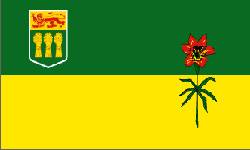|
**
WARNING **
Old Abandoned Underground Coal Mines can be
Very Dangerous,
Due to Collapse, and Mine Gases (Noxious and Flammable).
Extreme Care should be taken around them, due to Falls, Sudden Ground Collapse,
and Bad Air,
and in NO Circumstances should People enter into ANY Mine Openings, or
Associated Caves.
The Material Contained on my Sites, is NOT to Encourage Personal Investigation
of these Mines,
But only as a Historical Record of these Long Abandoned Mines.
Please View these Mines from a Far, Safe and Legal Distance.
Always Observe Private Property Rights, and Obey ALL Warning Signs.
************************************************
|
Hugh Hassard Coal Mine
later Souris Valley Coal
Mining Company Limited
The First Commercially Productive Coal Mine
in SE Saskatchewan
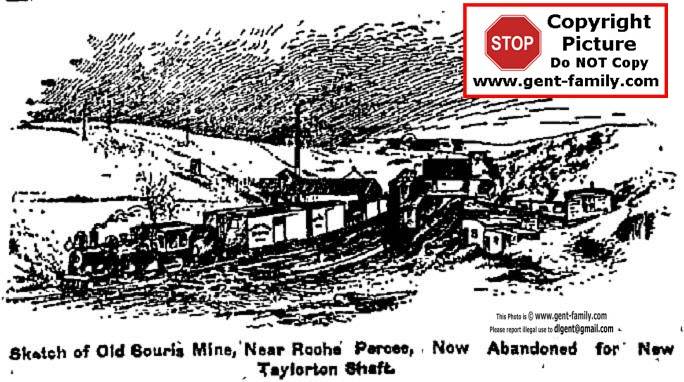
Sketch above ca Jan 1906
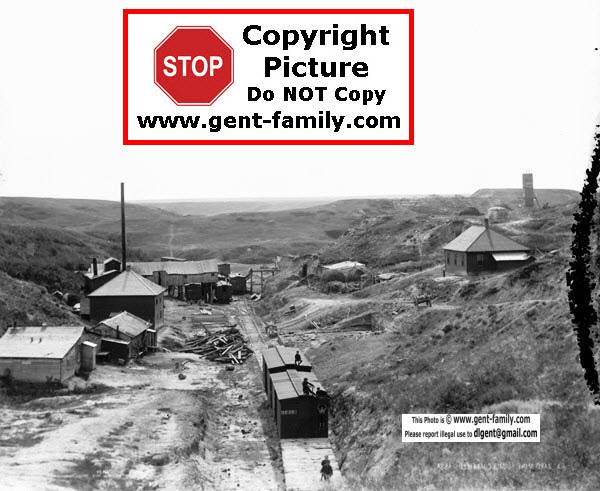
Source-
http://data2.archives.ca/ap/a/a012304-v6.jpg
Credit: William James Topley/Library and Archives Canada/PA
and Canadiana.ca portal,
Hassard mine
Located on
SE 1/4 Section 4, Township 2, Range 6, W2
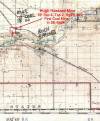
North side of the river.
About 1 1/2 miles east of Roche Percee
The First Coal Mine in SE
Saskatchewan
Operated
by Hugh Hassard.

The Bienfait 1955 History book
said the mine was operated by H. Hazzard in 1890.
I have seen the name Hassard, and Hazzard.
There is a Hazzard buried in Bienfait,
so you would think that is the
spelling of the name, wrong!
Some history books say his name was Robert Hassard.
which fits nicely with the Robert J. Hassard
who ended up in the Bienfait mines, but that is incorrect too.
Hugh Hassard was actually the Father of Robert J. Hassard.
His name is clearly Hugh in the land grant papers.
(see below)
One source says Hugh Hassard, an
early settler in the area,
was digging into the bank to make a stable, when his
shovel hit coal.
Hugh Hassard
b- Apr 1850 in Ireland,
d- Oct 17, 1929, at his home in Medicine Hat, AB, age 79.
Buried Oct 21, 1929, plot C 137E 10N D in Medicine Hat, AB
Shown
in the 1881 Canadian Census, age
30.
Shown as a farmer, Church of England (Anglican).
Census place= Dufferin, Marquette, Manitoba.
In 1911 census he was 61, born April 1950, in Ireland.
His wife was Jane Robinson, age 25, in 1881. (note 4 below)
In 1911 census she was 56, born in 1855.
Dufferin Manitoba was not far from Roche Percee area.
Now here we see the name Robert, a son, age 2 in 1881,
Would make him born in 1879 approx.
Not giving up on my search to really verify his name,
I finally hit pay dirt,
same as Hugh did, with his coal mine.
I found the family history in a book
"Cypress Hills Country".
They came from Larne Ireland in 1873.
Larne is in County Antrim, Northern Ireland.
They must have spent a few years in the Ontario area.
as the 2 oldest daughters were born there.
Between 1877 and 1879 they came to Manitoba,
settling at Moose Mountain, they say,
45 miles from Emerson MB.
July 9, 1883, He was actually elected
Justice of the Peace
with 2 others, in Moose Mountain.
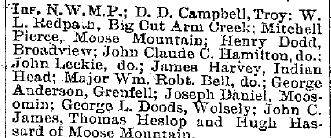
Another book listed him as an issuer of marriage
licences
West End, Moose Mountain
Most books say In 1882 the Hassards came to the Roche Percee area.
But if he was elected Justice of the Peace in 1883,
in the Moose Mountain area,
this can not be quite true.
I think the true date would have to be fall of
1883, or even into 1884.
He might have made investigative trips in 1882 though.
Now if I was a betting man, I would bet, Hugh Hassard,
seen the Pocock brothers, on their way back to Emerson,
and eventually Winnipeg, with their 2 large Coal samples.
He either seen them or heard about their find.
If he lived in the Moose
Mountain area, he might have known Chris Troy,
and maybe this
was his hired man?
Hugh seen this as his opportunity to get in there,
set up a homestead, and mine some coal,
before the Pocock boys returned from England.
An Irishman beating an Englishman!
But at the same time Hugh Sutherland a Scot entered the picture.
What a mixture, if I do say so myself.
I just don't think this was a pure coincidence.
Something made him come to this area from Dufferin.
This mine, and the Hassard family is mentioned in the book
Trooper in the far North-West
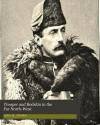
written by NWMP officer Corporal John George Donkin,
Chapter 23.
(see Note 2 below)
Mr. Donkin and another officer, constable Stewart, stayed at Mr Hassard's one winter.
He describes the mine as being in a ravine in front of the house.
Mr. Hassard had a hired man at the time, and had dug a 100 ft tunnel
in an 8ft seam of coal, using picks and felling axes.
In this chapter is an excerpt from the Feb 1888
Leader Post. It says
Mr. H.
Hassard was working this mine.
The Leader Post correspondent describes the mine,
"coming across the prairie there is a deep ravine,
down in this hollow buried under the lofty bank is the mine"
Coal was sold at $1.00 / ton to the local settlers,
some as far away as 80 miles. I've read articles as far as Carlyle and beyond
came for this coal. Caravans of wagons were seen at this time.
Corporal Donkin describes the location of Hassard's white washed house,
2 miles from the Frontier line, on the north side of the Souris River.
Hassard also had a kiln, and was selling lime at 20 cents/bushel.
He had a stable a short distance from the house, using the cut bank as a back.
Hassard also had a few log buildings thatched with straw or manure.
He had cows, sheep and some ponies.
The NWMP had a small barrack room attached to the house.
He writes that there was a deep coulee running down to the Souris,
which had a bend at this point, which doesn't help much,
since the Souris bends everywhere.
This mine was well developed by
1891.
We know the mine was on the north side of the river
for sure.
We know it was close to his home.
We know it was near a
ravine,
and we know it was near a bank,
as the mine was driven into the
side of the bank.
Possibly located in a deep coulee,
due south of the old
stone Taylorton store.
Hugh Hassard
took out a Land Grant, on Jan 21, 1892
with reserved mineral rights,
on SE Sec 4,
Tsp 2, Rge 6 W2.

Problem is he also took out a couple more,
NW Sec
16, Tsp 9, Rge 6, W2nd
and SW Sec 10, Tsp 2, Rge 5, W2,
but last 2 are
not in this area.
Using this land grant info I am confident
this is the location of this
mine.
According to
Roy
Sanderson's map,
it was located north of the Taylorton Cemetery.
So between the old Stone Taylorton Store, and the Cemetery,
there should be a
mine, and remnants of an old stone house, and kilns.
I give Roy a lot
of credit, for saving the history of this area.
But then this history is no longer online,
thanks to the Estevan cap site being removed from service.
All that oil money and no money for that???
The first Shipping of coal by rail was out of Bienfait,
Teams and Wagons, loaded
by hand,
carried the coal from the Hugh Hassard mine,
to the siding in Bienfait,
and this was hand shovelled into rail cars.
When the Soo Line,
through to Portal was built
they switched to the siding in Roche Percee.
Later when the mine became the Souris Valley Coal Co.
a spur line was built to
the mine.
1891 Census on Page 25, shows the family in Roche
Percee area
http://data2.collectionscanada.gc.ca/1891/pdf/30953_148227-00775.pdf
Dec 20, 1892 article below, shows his mine producing 60
tons per day.
Mr. Thomas T. Thompson of Oxbow handled the sales of the
coal.
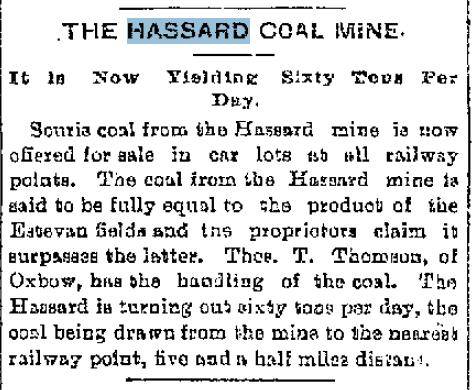
Dec 20, 1892 ad, again showing Mr. Thompson's name
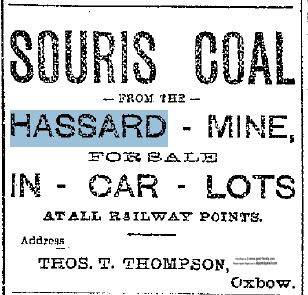
July 27, 1892 article below, clearly shows samples
of the mine
were being sent on display, to encourage buyers.

Dec 1, 1893 Hugh
Hassard sells the Mine,
but looks like he stays on as a part owner.
The organizers of the new company
D. C. Cameron, and Richard Hall of Rat Portage,
A. Cockburn of Winnipeg,
and Thomas T. Thompson from Oxbow
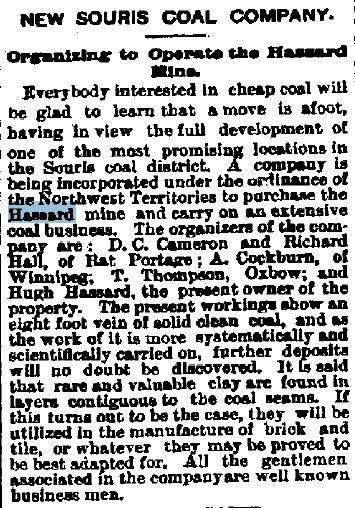
Rat Portage is now Kenora ON.
Sir Douglas Colin Cameron (1854-1921)
http://gent-family.com/SK_Coal_Mines/sirdouglascameron.html
was elected Mayor of Rat Portage, 1901-1903
He was Lieutenant-Governor of Manitoba, 1911-1916
He was a lumber merchant, with other interests.
Richard Hall was President of the Board of Trade there,
President Liberal Conservative Assoc. of Rainy River District,
Partner with a Mr. Seager in a Land Surveying,
and Mining and Mechanical Engineering firm,
and was an agent for Rock Drills used in mining.
found 2 Richard Hall's in Rat Portage area, 1891
both born in Quebec, one in 1850, other 1863.
Richard Hall
b- Mar 25, 1850 in Quebec
Mining Engineer, why I think this is the guy.
living in Rat Portage in 1901
Scotch, Presbyterian
wife- Agnes Hall,
b- Dec 24, 1852, in Quebec
Irish nationality
3 sons:
William K. Hall
b- Feb 2, 1876
Doctor in 1901
George Hall
b- Feb 19, 1879 in Quebec
Dentist in 1901
Harry E. Hall
b- May 22, 1886 in ON
there was a Richard Hall
b- 1863 in Quebec in Winnipeg in 1901
but he was a Railway Conductor, so don't think it was him

Souris Coal Mine Engine 1

Souris Coal Mining Company building
In 1895 this mine became
"The Souris Valley Coal Company Limited" Mine.
Here is the
Mineral Rights Land Grant form
for the East half of Section 4, dated
Mar 10, 1905.


May 2, 1902
Souris Coal Mining
Aug 28, 1905, they acquired the west half of this section,

In 1905 (see note 3 below),
after Mar 10th obviously, as shown above,
the Souris
Valley Coal Company Limited,
sold this mine to the Taylor family of Winnipeg.
It was
renamed Western Dominion Collieries Ltd,
and the Mining town of
old Taylorton got it's start.

July 5, 1906
Souris Coal Mining Co Ltd. Letterhead

June 24, 1907
Western Dominion Collieries Letterhead
letterhead photos courtesy Rob Taylor
G-Grandson of Richard R. Taylor Sr.
A book written in 1924, states he built a concrete house,
and it was still being
lived in by someone at that time.
It stated he dug coal in the bank of a ravine, just below his house.
This same book describes at this mine there were 2 drifts,
Mr. Hassards
and another run by Mr. Price.
The coal seam was 8ft thick,
and
they tunnelled straight into the side of the bank,
using wood timbers to
shore up the roof and walls.
Wagons would be hauled in to the mine
backwards by an old Ox,
and the wagon left there to hand load.
When full the farmer would hook onto the wagon with his team of horses,
and haul his load home for $1.00 a wagon load.
It also says in 1891 there were 2 or 3 coal seams on fire.
One source says the first owner sold his interests
and moved to the southern United States,
which totally explains why I couldn't find him
in any Canadian census in 1901 or 1906.
Then
I found a newspaper article, dated Apr 3, 1896,
that says, Hugh Hassard of the
Coalfields,
leaves next week for his new home in Alabama.
So now we know
almost exactly when he left the area.
Wonder why they went to Alabama?
The family appears in the US 1900 census, taken June 12,
1900,
Hugh is shown as a Dairy Man.
married for 26 years.
Hugh shown as age 50, wife Jane 44.
living in South part of Precinct no 9, Jefferson Co, Alabama
Then in 1901, per the family history,
he came back to settle in the area of Josephsburg,
north of Elk Water Lake, in Alberta,
eventually selling milk in Medicine Hat..
The 1911 census says he came to Canada in 1909,
not 1901 as the history book says.
They are not in the 1901 or 1906 census, so 1909 looked accurate.
But then CPR land records show probably 1901 is correct.
June 8, 1901 he bought 160 acres for $3.00 per acre.
NW Sec 7, Tsp 9, Rge 2, W 4th
Aug 25, 1902, he bought another 160 acres, for $3.50 per acre,
NE Sec 7, Tsp 9, Rge 2, W 4th
Then Mar 28, 1903, he bought 320 acres this time,
for $3.50 and acre.
SW and SE Sec 7, Tsp 9, Rge 2, W 4th
Then June 19, 1903, he bought a further 160 acres at $3.50,
NW Sec 5, Tsp 9, Rge 2, W 4th,
So he ended up owning the whole section 7, SE of Medicine Hat.
plus the extra 1/4.
So we now know, between Mar 31, 1901, and June 8, 1901,
they returned to Canada.
He eventually moved into the city of Medicine Hat, before 1911 census,
and in 1912
became the first Librarian at the new Public Library.
He earned $25.00 a month as librarian.
He was instrumental in starting an Unemployment Bureau in the city.
If that wasn't enough, he was the Local Meteorologist,
with all the instruments on his roof.
Now if this isn't movie material, I don't know what is!
Amazing, go from Farming, to Coal Mining,
to Dairy Farmer,
to Librarian, to Meteorologist.!
Then having one of your sons carry on on the Coalfields,
owning or operating many mines.
May 1928 he was given permission to use city owned lots,
to establish an experimental nursery.
In the 1916 Canada census, he is shown born in Ireland in
1850,
age 66, living in Medicine Hat at 803-B 4th St.
Says he immigrated
in 1901.
So here again we have 1901, not 1909?
Hugh Hassard died at his home, Oct 17, 1929, age 79.
Buried Oct 21, 1929, plot C 137E 10N D
Imagine the stories this man could tell!
He is buried in Medicine Hat Cemetery, off 10th Ave. SW
with his wife Jane Hassard, nee Robinson.
b- May 1856 in Ireland
d- Oct 3, 1933, age 77.
Buried Oct 6, 1933, plot C 137E 10S D in Medicine Hat Cemetery
Jane's father- James Robinson
b- June 19, 1862, in Larne, Atrim Co, Ireland
occupation in Ireland was a Captain of a ship.
immigrated in 1882
d- in Canada
Jane's mother- Barbara Ellen Dunn
born in Northumberland England
Immigrated in 1888
daughter of John Dunn
died in Ireland
Jane Robinson had 4 siblings
Jane's grandfather- John Robinson
son of James Robinson
immigrated to SK in 1886
married July 21, 1854 in Larne, Antrim, Ireland
her grandmother- Eliza Workman
Eliza daughter of George Workman
immigrated in 1888 to SK
died in Ireland
Hugh and Jane actually had 11 children.
1. Elizabeth Hassard
b- ca 1871 in Ottawa, ON
d- ?
was 10 years old in 1881 census,
born in Ottawa, Ontario, Canada
2. Martha
b- Jan 15, 1877,
in Prince Arthur's landing,
now Port Arthur,
Thunder Bay District, Ontario, Canada
d- ?
shown age 4, in 1881 census, born in Ontario.
3. Robert,
(Robert J. Hassard)
b- ca 1879 on the homestead, near Morden MB
d- 1952 in Medicine Hat, AB
He is shown age 2 in 1881 census, born abt 1879.
It says, "He owned and operated the
Coalfields
at Bienfait
for many years, until he retired"
Robert is shown in the 1916 as age 37, born in 1879 in Manitoba.
He
was living in the Assiniboia district in SE Saskatchewan at that time.
4. James Hassard,
b- Oct 1880, at Morden MB.
d- ?
He was 5 mo old in 1881 census.
James (Jim) Hassard went to school in Bienfait..
James's son Robert P. Hassard worked in the Bienfait Mines
for Robert J. Hassard, his Uncle. another Robert!
Nothing in the Manitoba Vital stat records for Robert or James births,
which is a bit strange.
I believe James lived in Eagle Butte AB.
in 1925 he was chosen announcer at the Medicine Hat Stampede.
5. George Hassard
b- Apr 1883, at Moose Mountain,
d- ?
he might have died in Medicine Hat, AB, ca 1950
this very well could be the George Hassard that owned what was known
as the Dowling ranch, 13 miles south of Piapot, and 4 miles east.
this guy was a bachelor who sold the ranch, and retired to medicine hat in 1948.
He was a well known horse man in the area.
nothing verified.
6. Annie Hassard
b- ? at Moose Mountain also.
d- ?
there is an Anna Hassard buried in Medicine Hat, d- Mar 6, 1961
but I think that is Claude's wife, see below
7. William (Willie) Hassard
b- Mar 1887 on the Coalfields Homestead,
at the mine location, in the old log house.
d- ? in the US
He lived and died in the United States.
Then they must have built a stone house at the mine site,
as the next 3 were born there.
8.
Hugh (Jr.) Henry Hassard,
b- Sept 9, 1892, per SK vital records, and death cert,
in the new Stone house, Coalfields, SK.
d- May 16, 1941, in Vancouver BC, age 48
shown born in Estevan when he enlisted in WWI
on Feb 9, 1815 in Medicine Hat, AB
next of kin, his mother Jane
4th St, Medicine Hat, AB
occupation- Lineman, single
1900 US census says born Nov 1890 which is wrong.
married Ada Larose Hassard, nee ?
9. Claude Hassard
b- Nov 1900, in the Coalfields, in the new Stone House.
d- Mar 26, 1976?
buried in Medicine Hat Cemetery
Claude became the World Champion Bronc rider in the States.
1900 US census says born Oct, 1888
same Claude, born 1890, died Mar 26, 1976
married Anna Johnson
there is an Anna Hassard buried in Medicine Hat, d- Mar 6, 1961
10. Albert (Bud) Hassard
b- July 1903, in the Stone house.
d- ?
1900 US census says born May 1895
I believe he might have married Edna Callfas,
and in 1980 might have resided in Victoria, BC
11. Jane (Jean) (Jannie) Hassard
was born
July 1899, near Birmingham Alabama, USA.
In 1916
census she is 17 living with her parents
in Medicine Hat, Alberta Canada.
1900 US census she is 11 months old.
Note 1- an early settler's name of Hassard,
was used for a lake in Moose Mountain area.
Located at 9-5- W2, 11 miles from Arcola. I think this might be
named after our Hugh Hassard family
|
Latitude - Longitude : |
49° 47' 00" N - 102° 35' 00" W |
Note 2- An interesting side note, this Mr.
John George Donkin, b- June 7, 1853 in Morpeth, Northumberland, England, son of
Arthur Scott Donkin (MD) and Mary Moor, went back to
England, after he paid his way out of the NWMP, on Mar 12, 1888, wrote the book
Trooper in the far North-West, and obviously
fell on hard times, with alcohol abuse, as he died penniless in the Alnwick
Union Workhouse, at Bondgate Without, Alnwick, Northumberland, England, on Jan
3, 1890, at the young age of 37.
An even more interesting twist on Mr. Donkin, he was also a
suspect in the Jack The Ripper case. He had medical training when he was
younger, and had made statements implicating himself in the case in London.
His name became John Davidson in 1888, and he signed his name as J. Duncan,
another alias, probably to conceal his prior legal problems. His book was
written in his real name though. He was married between Oct-Dec 1874, to
Margaret Josephine Forster, in the district of Rothbury in Northumberland, then
divorced some time after 1881 census. In 1881 UK census he was living at
his mother-in-law's place, still with his wife, at Tynemouth, Northumberland.
He spent 2 terms in prison in Newcastle, for assaults upon women, around 1881,
probably just after the census was taken. Possibly one was his ex wife?
Now this might explain why he went to
Saskatchewan with not much money, and endure the terrible conditions of the time
there, to get away from all these legal problems he had. I wonder if Mrs.
Hassard had any idea who was living under her roof? Then again he was only
a suspect, and provided a believable alibi in the case, so who really knows.
He was quoted as saying he committed the murders. Would an innocent man do
that? Maybe the booze made him say he did it. Possibly the booze
made him do it.
Note 3-
Found another article dated Jan 27, 1906, it states R.R. Taylor managed
the Hassard, Roche Percee and Taylor mines,
all close to each other it says. In
1901 he combined these 3 mines.
He then decided to close the Taylor
mine,
and by 1904, only the Hassard and Roche Percee Mines were
operating. So was he the manager, or did he own them as early as
1901? Was he part of the Souris Coal Mining company Ltd owners group, but
not mentioned in the article above?
Note 4-
Turns out Hugh's wife, Jane Robinson's father and mother lived at Moose Mountain
very early on, with nothing south of them until North Dakota. |
